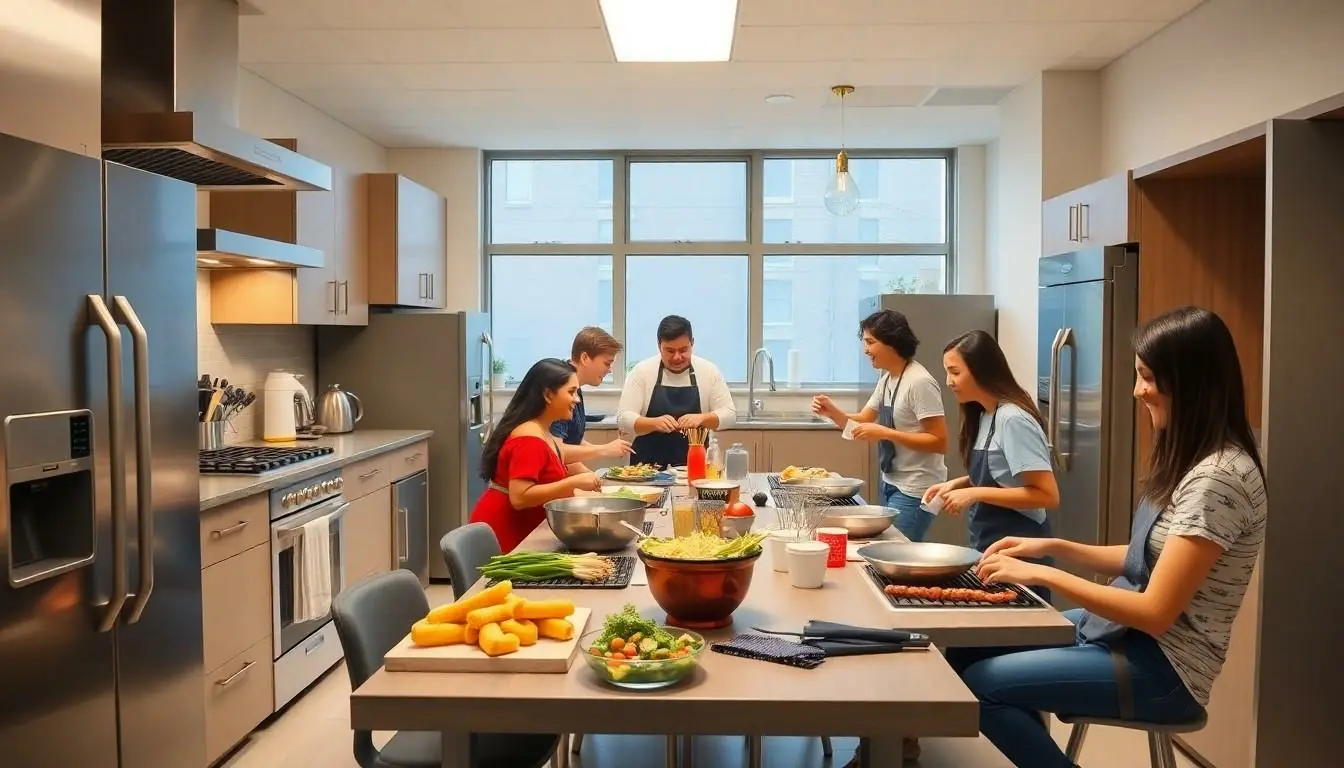Table of Contents
ToggleWhen the hunger pangs hit and instant ramen just won’t cut it, the question arises: do dorms have kitchens? For many students, the dream of whipping up a gourmet meal in a cozy kitchen is as elusive as a good Wi-Fi signal during finals week. Some dorms boast full kitchens, while others leave students to navigate the culinary wilderness with nothing but a microwave and a prayer.
But fear not! Whether it’s a communal kitchen or a shared microwave, dorm living can still offer some culinary adventures. Understanding what your dorm has to offer can make all the difference between surviving on takeout and becoming a master chef—at least in your own mind. So let’s dive into the world of dorm kitchens and discover whether students can channel their inner Gordon Ramsay or if they’ll be stuck with cold pizza and cereal for the foreseeable future.
Overview of Dormitory Facilities
Dormitory facilities vary widely across colleges and universities. Some dormitories feature full kitchens equipped with stoves, ovens, and sinks, allowing for elaborate meal preparation. Others may provide kitchenette areas, which typically include microwaves, toasters, and sinks, catering to basic cooking needs.
In many cases, common areas may also include communal cooking facilities. Shared kitchens foster opportunities for collaboration among students, paving the way for group cooking events and culinary experimentation. On the other hand, certain dorms enforce cooking restrictions, opting for dining halls as the primary food source.
Limited kitchen access doesn’t prevent students from enjoying meals. Utilization of hot plates or electric kettles provides alternative cooking methods, even in dorms with restrictive policies. Grocery access remains essential. Local grocery stores often supply students with ingredients that suit their cooking preferences and dietary needs.
Food delivery options can also supplement students’ culinary experiences. In cases where on-site cooking isn’t feasible, accessible food delivery services bridge that gap, ensuring that students maintain their nutritional needs without sacrificing convenience.
Several factors influence the availability of kitchen facilities. Location, type of institution, and budget often determine what amenities are offered. Students might find that technological advancements in kitchen appliances enhance their cookingoptions, making even basic systems more versatile.
Not all dorms offer the same resources. Students should research specific accommodations at their chosen schools to understand what cooking facilities await them. Engaging with campus living options remains a wise move for those interested in home-cooked meals during their academic journey.
Common Features of Dorms


Dormitories come with various features, accommodating students’ diverse needs. Some may include kitchen access, while others might focus on basic amenities.
Types of Dormitories
Public universities often provide traditional dorms, where students share rooms and communal spaces. These setups typically foster social interaction, allowing residents to build connections. On the other hand, private institutions may offer suite-style living, where several bedrooms share a common living area and sometimes a kitchenette. Specialized housing options, like themed dorms, can cater to particular interests, creating unique living experiences for residents. Overall, the type of dormitory influences the available amenities and community environment.
Amenities Offered
Basic amenities generally found in dorms include laundry facilities, study lounges, and Wi-Fi access. Many dorms also provide furniture essentials, such as beds, desks, and chairs. Kitchen facilities vary widely; some include full kitchens while others feature only microwave units. Certain dorms promote health and wellness with fitness centers or recreational areas. Local dining options and food delivery services complement these amenities, giving students additional choices for meals. Understanding the specific amenities available helps students make informed housing decisions.
Do Dorms Have Kitchens?
Dormitory kitchens come in various forms, depending on the type of housing. Some facilities offer well-equipped kitchens, while others provide minimal resources.
Kitchen Availability in Different Types of Dorms
Campus housing varies significantly in kitchen availability. Traditional dorms often feature community kitchens shared among residents, fostering social interactions. Conversely, suite-style dorms cater to privacy and may include private kitchenettes for shared living spaces. Specialty housing options can also provide unique cooking amenities tailored to specific themes. The type of institution largely influences kitchen options, so prospective students should consider these differences while selecting their accommodations.
Shared vs. Private Kitchens
Shared kitchens promote communal cooking experiences, allowing residents to collaborate on meals. Many dorms equipped with shared kitchens encourage students to bond over cooking, enhancing their college experience. On the other hand, private kitchens offer more convenience, providing opportunities for individual meal preparation. Students with dietary restrictions or unique culinary preferences might prefer these private options. Ultimately, the choice between shared and private kitchens impacts daily living and influences students’ cooking habits and social interactions.
Benefits of Having a Kitchen in Dorms
Access to a kitchen in dorms offers numerous advantages for students. Cooking meals promotes healthier eating habits, as students can choose fresh ingredients and prepare dishes that align with their dietary needs. Social interactions increase when students share communal kitchen spaces. This environment fosters friendships and bonding through shared cooking experiences.
Convenience plays a critical role as well. Students can save money by preparing their meals instead of relying exclusively on expensive dining options or food deliveries. Even a basic kitchen setup allows for cooking simple dishes, allowing students to enjoy home-cooked meals.
A kitchen also supports culinary creativity. Limited resources can inspire innovative cooking techniques and recipes. Students learn essential cooking skills that can benefit them long after their college years.
Time management improves with access to kitchen facilities. Preparing meals in advance can free up time during the hectic days of studying and attending classes. Having the ability to heat leftovers or make quick snacks enhances overall efficiency.
Flexibility increases with kitchen access. Students can cook according to their personal schedules rather than adhering to dining hall hours. This freedom also accommodates late-night cravings and unexpected gatherings.
Many students find that cooking together in dorm kitchens enhances their college experience. Shared cooking events can become social gatherings, providing opportunities for collaboration. Ultimately, having a kitchen in dorms enriches daily life by enhancing nutrition, social connections, and personal development.
Tips for Cooking in a Dorm Kitchen
Cooking in a dorm kitchen presents unique opportunities and challenges. Begin by organizing the kitchen space to maximize efficiency. Keep essential items, such as pots, pans, and utensils, easily accessible. Opt for multi-functional appliances when possible, like a microwave that can also grill.
Plan meals ahead of time. Preparing a weekly menu allows students to purchase ingredients in bulk, reducing both food waste and expenses. Try to store perishable items properly to maintain freshness. Use clear containers to keep ingredients visible and organized.
Engage with fellow students for group cooking sessions. Sharing meals promotes community and exploration of different cuisines. Establish cooking clubs in dorms to develop cooking skills and bond over food.
Understand the limitations of the kitchen. Some dorms strictly regulate cooking, so follow established guidelines. Using small appliances such as electric kettles or hot plates can still facilitate meal prep even when larger stoves aren’t available.
Explore local grocery stores and markets for fresh ingredients. Supporting local vendors not only enhances meals but also strengthens community ties. Consider ordering groceries online for convenience if students prefer more variety without the hassle of travel.
Embrace the opportunity for culinary creativity. Even with a limited kitchen setup, simple recipes can yield delicious meals. Experiment with quick dishes like stir-fries or salads, utilizing the available equipment to make nutritious options.
Invest in essential cooking tools. A good knife, cutting board, and mixing bowls can significantly improve the cooking experience. Many students find that a few quality items lead to better meal preparation and enjoyment.
Navigating the kitchen situation in dorms can be a rewarding experience for students. With a variety of cooking facilities available students can adapt their culinary habits to fit their living arrangements. Whether utilizing communal kitchens or private kitchenettes students have the opportunity to enhance their cooking skills and foster social connections through shared meals.
Even in dorms with limited kitchen access there are creative ways to prepare nutritious meals. By exploring local grocery stores and leveraging food delivery services students can enjoy a diverse range of options. Understanding the specific amenities and cooking resources at their chosen institutions will empower students to make the most of their culinary journey while living on campus.



